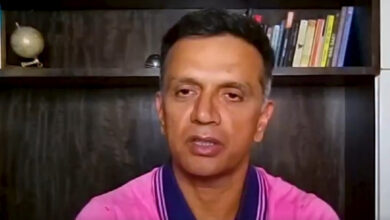‘Hamare spinners kahan hain’: Inefficiency of spinners has been Pakan’s biggest letdown this World Cup | Cricket-world-cup News

In a heated television studio in Lahore, where former captains and legends of Pakan are tearing into their batsmen’s ineptness to deal with a semi-turner, the surreally serene Mushtaq Ahmed, calmly intervenes: “Hamare spinners kahan hain?” The rhetorical one-liner contained one of Pakan’s biggest letdowns in this World Cup, a catalyst of their premature doom.His co-panels, Shahid Afridi and Mohammed Yousuf, would take over the thread with considerable angst and detailed theories. From bland captaincy and global warming to changed soil nature and insufficient tending of the surfaces, they fish out every possible point behind the inefficiency of spinners. Mushtaq’s deduction is simple: “They were bowling to stop runs and not to pick wickets. They were bowling like in T20s, not attacking enough and always scared of the boundaries.”
Follow all the action from the Cricket World Cup 2023 on our special World Cup section. You can also find the latest stats, like the top scorer and the highest wicket-taker of the current edition, upcoming World Cup fixtures and the points table on the site.
The long lineage of Pakan twirly-men, at the peak of their white-ball domination, were not like them. Apart from their splendorous skills and vibrant imagination, taking wickets was their sole pursuit. Abdul Qadir once whipped up an anecdote to The Daily Telegraph: “We were defending a low total in the West Indies and I suddenly started to bowl defensive lines. We won the game and I didn’t concede too many runs, but Imran came and told me that you bowled poorly. It’s a crime for spinners to bowl with the fear of getting hit,” he recollected.
Thereafter, from Qadir to Mushtaq and Saqlain Mushtaq to Saeed Ajmal, spinners from Pakan replicated the same aggression as their pacers would. Even Shahid Afridi, a modern-day leg-spinner, would hunt for wickets rather than be content just stopping boundaries. Not surprisingly, a spinner featured prominently in their golden age in most World Cups from 1987 to 2011, where they twice reached the last four, besides lifting the trophy and emerging finals once.
In 1987, Qadir (16) finished the second-highest wicket-taker after Imran Khan; in 1992 and 1996, Mushtaq Ahmed was his country’s second-most lethal bowler (16 and 10 wickets each); in 1999 Saqlain Mushtaq topped his country’s bowling charts, in a starry bowling line-up that featured Wasim Akram, Waqar Younis and Shoaib Akhtar. the time 2003 winked in, Saqlain was a fading force and so were Pakan. So were they in the catastrophic 2007 installment, before Afridi retooled himself from an attacking opening batsman to a middle-over leg-spin destroyer. He claimed 21 wickets to charge his side to the semifinals in 2011.
Twelve years later, in their next trip for a World Cup in India, their quartet of spinners winkled out only 12 wickets, each of them costing a nudge under 90 runs, conceding 6.2 an over, and striking once every 88th ball. That their most trusted spinner was a part-timer – Iftikhar Ahmed – captures the story of Pakan’s deficient spin stocks. He bowled more overs, picked up more wickets, and conceded fewer runs an over than their preferred spin pair of Shadab Khan and Mohammed Nawaz.
At the heart of their shuddering performance was the fallacy that efficient T20 spinners could be influential 50-overs practitioners too. The driving logic seemed to be that if they can be thrifty in a format as demanding as T20s, where the margin for error is supposedly high, they could be more impactful in ODIs too. Little doubt that the pair is terrific in T20Is, a format that launched their fame and international career. Aside from the World Cup, they were reasonably economical too. Nawaz concedes just 5.09; Shabab 5.23. But they average 35.88 and 34.15.
To pers with both seemed an outdated strategy, for these are times when most teams deploy their spinners as attackers in the middle overs, where grabbing wickets holds a higher value than stopping runs. It is no coincidence that each of the four teams in the semifinal has a spinner capable of picking wickets. Australia’s Adam Zampa is the leading wicket-taker of this tournament (22); New Zealand’s Mitchell Santner has 16, Ravindra Jadeja and Kuldeep Yadav have 14 and 12; Keshav Maharaj has 14.Most Read
1
After woman’s post about train ordeal goes viral, Railway police say taking measures to avoid such incidents
2
A plan to join the Red Sea with Mediterranean — an alternative to the Suez Canal
See More
Watching each of them has been a spectacle—their tricks and teasing, the craft and cunning, the wit and wisdom, the game sense and awareness. On the contrary, their Pakan counterparts have looked to rush in and complete the overs like they do in T20. Bowl flat, on the stumps, keep mixing the lengths. Such methods don’t work in ODIs because batsmen have time to gauge a bowler and then line him up. Shabad burst forth with the reputation as a big turner of the ball, but in his pursuit for T20 excellence, he forsook his natural gifts and retooled himself as a flattish leg-spinner in Afridi mould, but without his snap or bite off the surface, bereft of his aggression and cunning. Former opener Aamir Sohail noticed in The Dawn that “Shadab is gripping the ball very tightly which is locking his wr and as a result, he is not getting the spin and delivering (unintentional) full-pitched balls.”
Nawaz was the typical utility player, flat and quick, whose biggest motive is to pile on the dots, without much subtlety of lengths or variations. Such one-dimensionality is irresibly punishable in this format. Among them, Mir looked the most attacking-minded, but the leg-spinner is still a study in progress and has rough edges.
The lack of quality spinners has been a larger concern. In Tests too, they have been struggling for a stable spinner after the fading of leg-spinner Yasir Shah so much so that Shah himself was recalled after a year in the wilderness. So dire that the last five of their 13 Test debutants have been spinners of one hue or the other. One among them is Abrar Ahmed, a leg-spinner who many in Pakan tout as the inheritor of Pakan’s spin-bowling legacy. Mushtaq brought up his name in the show, as did Afridi. Perhaps, he could answer Mushtaq’s rhetoric: “Hamare spinners kahan hain?”







